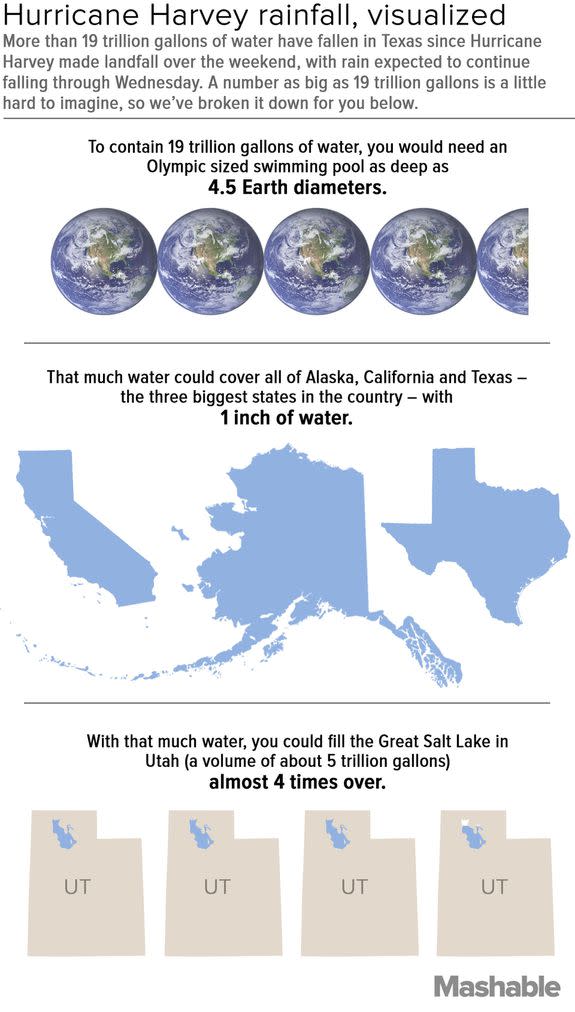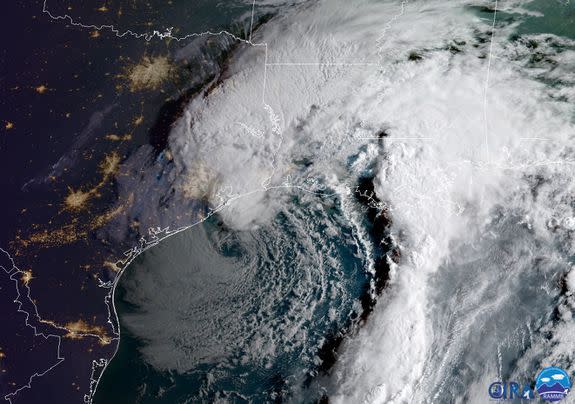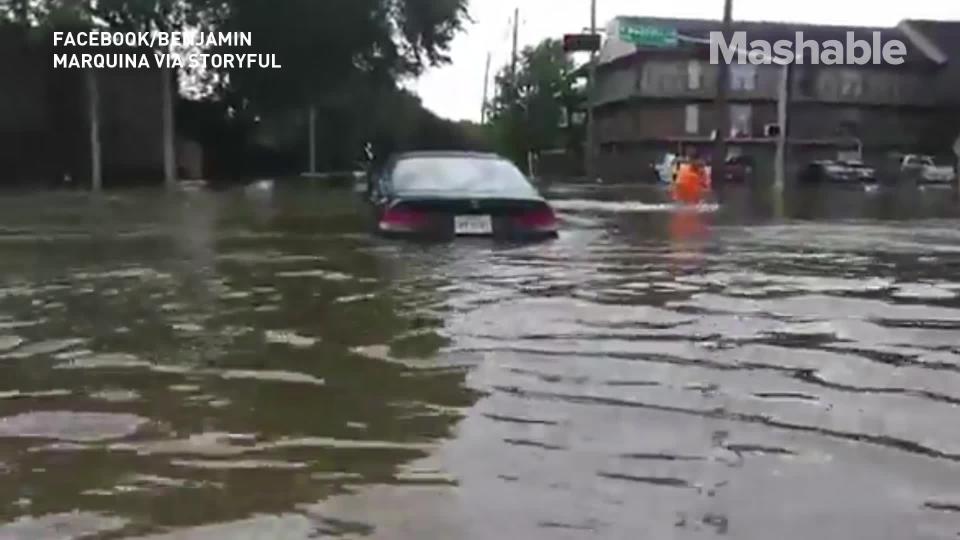Tropical Storm Harvey set a continental U.S. rainfall record, and other mind-blowing stats

Tropical Storm Harvey is making all of us sound like President Donald Trump when describing the epic nature of this flood.
From the National Weather Service talking about "catastrophic" flooding to forecasters discussing "unprecedented" levels of rainfall, Harvey has evoked a certain number of superlatives in the rhetoric of those following it closely.
SEE ALSO: Tropical Storm Harvey raises red flags on infrastructure, climate planning
Except — unlike many of Trump's blustery proclamations — the way we're talking about Harvey isn't hyperbole.
The situation in Texas really is that bad.
So, exactly how historic is this storm? We break it down by the numbers.
19 trillion gallons of rain (and counting)
According to meteorologist Ryan Maue of WeatherBell, a private forecasting firm, at least 19 trillion gallons of water has fallen on Texas since the storm began. A whopping 1.2 trillion gallons has inundated Harris County alone, Maue said.
The total of 19 trillion gallons is enough to cover all of Alaska, California, and Texas in about an inch of water.

Image: Bob al-greene/mashable
51.88 inches of rain (and counting)
The National Oceanic and Atmospheric Administration is now reporting that Cedar Bayou, Texas has received a staggering 51.88 inches of rain. This marks a new rainfall record for any tropical storm or hurricane in the lower 48 states.
It edges past the record for the most rainfall ever recorded from a tropical storm or hurricane in the lower 48 states, during a storm that hit Texas in 1978.
The record for total rainfall from a tropical system has been BROKEN! Mary's Creek at Winding Road recorded 49.20", previous record is 48". pic.twitter.com/yCjuUOR8p3
— NWS Houston (@NWSHouston) August 29, 2017
The National Weather Service forecast office in Houston called the rainfall totals "mind-blowing" and unequivocally stated this is the worst flood in Houston's history.
In a technical forecast discussion, the Weather Service said the flooding "will likely be the
largest economic U.S. natural disaster (certainly the costliest hurricane)."
Largest flood in Houston-Galveston history. #Harvey https://t.co/9vtV595qpu
— Eric Fisher (@ericfisher) August 29, 2017
A 1-in-1,000 year rain event
The rainfall amounts across the Houston area rank as roughly a 1,000-year event. This does not mean that it will be 1,000 years before the next flood of this magnitude occurs.
#Harvey has been a 1000+ year rain event for the Houston region, according to @UWCIMSS @UWSSEC. Our third 100+ year event in three years. pic.twitter.com/d8bRLJ3z3P
— Daniel Cohan (@cohan_ds) August 29, 2017
Rather, it means that in any given year, there is a 0.1 percent chance of seeing such a heavy rainfall event.
With climate change shifting the odds in favor of extreme rainfall events, return period calculations like this are becoming less useful to civil engineers who must design infrastructure to withstand historical floods.
6 million people
Harvey has brought at least 20 inches of rain to more than 6 million people, according to calculations by Ryan Maue, a meteorologist at the private forecasting firm WeatherBell.
Maue also found that more than 5.37 million people have seen 30 or more inches of rain because of this slow-moving storm.

Image: noaa/cira
In addition, a total of about 4.9 million saw at least 3 feet of rain from this storm, mainly in the Houston metro area.
“To maximize the population affected by a landfalling hurricane, you could not have picked a more treacherous place on the East Coast of Texas to envelope Houston," Maue said. "Just awful luck [and] placement.”
More than 3,500 people
According to the most recent estimates by the Houston Police, about 3,500 people have been rescued as Harvey's rains flood Houston and the surrounding areas.
In total, more than 17,000 people were in shelters on Monday night as a result of the storm, the Red Cross said Tuesday morning.
Last night in Texas, 17,000+ people sought refuge in shelters. We're providing safety & comfort to rescued families. #HurricaneHarvey pic.twitter.com/lTmVustMHt
— American Red Cross (@RedCross) August 29, 2017
A year's worth of rain in 5 days
Harvey brought about a year's worth of rainfall, or more, in a timespan of just the past 5 days. Houston's annual average is 49.77 inches, while Mary's Creek, Texas has picked up 49.32 inches since Friday alone.
To get a better idea of just how much water this is, consider that more rain fell in the past 5 days in Houston than typically falls all year in Chicago or Seattle.
Nearing a years worth of rainfall in parts of Texas (near Houston) in just the last 5 days pic.twitter.com/GuLYqJPuKC
— Terry Eliasen (@TerryWBZ) August 29, 2017
According to the Weather Service, Houston has seen more rain from June 1 and August 28 than it typically does in an entire year.
Untallied, but HUGE costs
We don't yet know what the cost of this event will be, insurance experts say. However, this has the potential to be the costliest hurricane and costliest natural disaster in U.S. history.
"We are very clearly looking at one of the costliest natural disaster events in this country's history, but until Harvey fully subsides and the totality of the damage is realized, we aren't going to know a specific cost value," said Steve Bowen, a meteorologist with AonBenfield.
"What makes this so challenging is that in addition to the catastrophic footprint of physical damage, there is going to be a significant cost from business interruption," he said.
For example, both of Houston's major airports have been shut down for days and may not open till the weekend, resulting in about 1,500 canceled flights per day as well as lost wages for airport workers, among other economic ripple effects.
WATCH: Hurricane Harvey is the strongest hurricane to hit the US in 12 years


